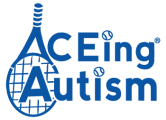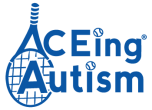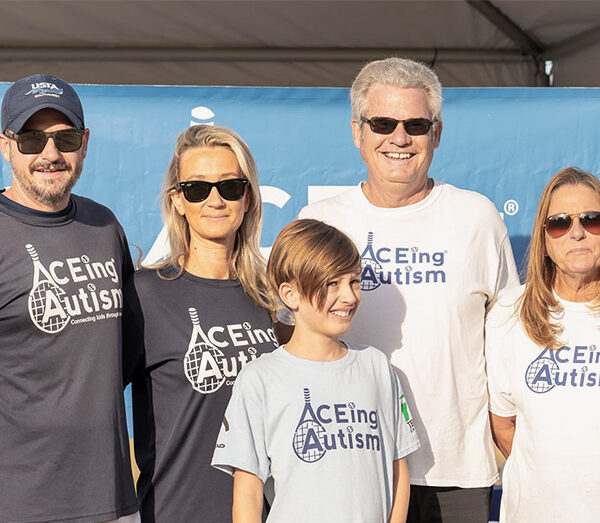What are your backgrounds?
Elana: I was a stay at home mom for 11 years and when my son started showing signs of delay, I started and completed a Master’s in teaching at USC in Los Angeles. Then I taught intervention classes for reading, for special education. I was Dean of Students and Director of HS, but once the pandemic hit, I home schooled Euan and focused on his language and making sure he wasn’t falling behind and building his confidence. He is now back in general education with a therapist with him and I went back to work as an education consultant.
Chad: I’ve been involved with USTA through my daughters and through our junior tennis program that we started in 2012. I learned about ACEing Autism through USTA Southwest as they were going to be a beneficiary at a tournament in Arizona. I then reached out to the section who put me in touch with Richard Spurling in 2016.
A program was started in 2016 at the site of the tournament in the outskirts of Phoenix But we finally started it in Phoenix in the Fall of 2017 and we ran it every year even through COVID-19.
How did Euan’s diagnosis come about?
Elana: Euan (12 years old now) had delays in speaking when he was around 2 years old. We went to speech therapy and continued for 7 years after that.
When he was between 2 and 4 years old, it was really hard to pinpoint what it was. He laughed, giggled, wanted to be social and it wasn’t until he went to preschool that we started to see frustration and started to show. We started to think about autism but people didn’t think that was it. We wondered if there was anything else we could be doing. Experts told us to do Occupational and Speech Therapy. We held off getting him tested because we were scared of the diagnosis to be honest and in the education system, they made it sound like a death sentence.
We moved to Phoenix when he was 5 years old, and it was more and more evident that he wasn’t speaking so we eventually got the diagnosis. Then, we found SARCS in 2015, a year later he went into ABA and it was the turning point for us. He has 32 hours of therapy a week.
He can now speak a lot more, he manages his emotions much better and he is social, that’s the biggest thing. When we started ACEing Autism in 2017, he didn’t participate, he wanted to throw the ball. Now, he is rallying. Autism is a community, it really is a family, everyone helps everyone.
Can you talk about the process of starting ACEing Autism?
Chad: Once we made the decision to start the program, it took several months. We rented courts from a High School, then it was about figuring out how long the program would be, what time of the year to do it, determine the right time of day (during the winter, Arizona can be quite cold, and spring time through fall is really hot), and mesh it with our junior program.
I leaned heavily on Justin Belisario, the Director of Programs. Volunteers are always the tough ones to get but they are at the heart of the program. At the end before the cheer, I have the participants applaud the volunteers to make sure they know how much we appreciate them. Volunteering recruiting started within our junior program, our friends, our families, then once you are able to get some people in, use these people to recruit friends.
So we were able to link up with a High School and the coach helped us but this took time. We did the same thing with a local university (club team). And finding ways to advertise the program, but I get super nervous to broadcast too wide because of the fear of not having enough volunteers. Lastly, it was to have Justin join us on week 1, as he took the lead and showed us how to lead a clinic.
Has your program evolved over the years? If yes, in what ways?
Chad: It’s mainly been through word of mouth, from families to families and volunteers to volunteers. We started with 6 and we had 18 at the highest.
You earned Program of the Year, how was that?
We were totally clueless about the Program of Year award. I had no idea, we didn’t know awards were going to be a part of it and it was even more surprising to hear our program had won. It was very special.
Any advice for people looking to be involved with ACEing Autism?
Chad: It is very rewarding and clearly rewarding for us. For kids on the autism spectrum, there are not many sports and recreational activities available to them.
There is a philosophy in the autism world about prioritizing integration. Have kids with autism interacting with kids or people without autism. It achieves that goal of bringing the community to the autism world and pushing the autism world toward the community.
It is super rewarding for us as parents because Euan gets to participate but I’ve also seen it through the volunteers and how rewarding it is for them.
Elana: It isn’t just about tennis, it’s about the whole experience, social piece, physical activity. It adds confidence to the kids, it’s a safe place for them to practice interaction while they’re moving, then hopefully it generalizes when they go to the school. When kids are moving, it is known to help with speech as well.
Chad: Lean on the ACEing Autism staff, ask for advice and help, there are a lot of things that HQ can do. A lesson we learned is that you need to rely on other people because there is a temptation to do it ourselves. For example, we established a new position (clinic director) where 2 High School kids help carry the load on the court. It gives them training and responsibility, it allows us to step back and make sure everything goes well. We were running like chickens at the beginning trying to get it done. Delegation for sure!
Last words?
Elana: The moment we got the diagnosis, I felt like my world was ending but it’s been amazing to have these clubs, nonprofits, areas of support to expand his world and make him feel included, like he is a productive and typical to a degree member of society. ACEing Autism is a piece of that community puzzle for Euan so it doesn’t feel like a death sentence anymore.
Chad: Keep pushing kids with autism toward society and pull society toward kids with autism to get these 2 worlds together and ACEing Autism does a great job of that. And when they encounter someone with autism that barrier has already been removed.





